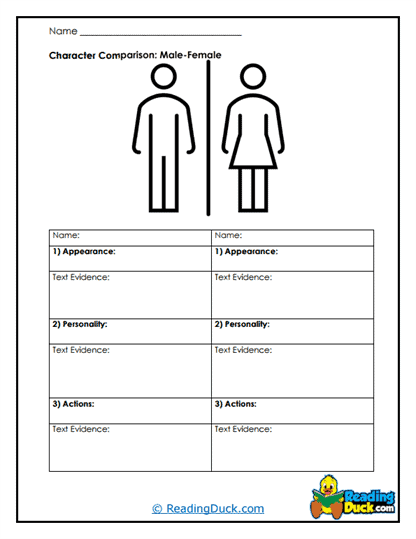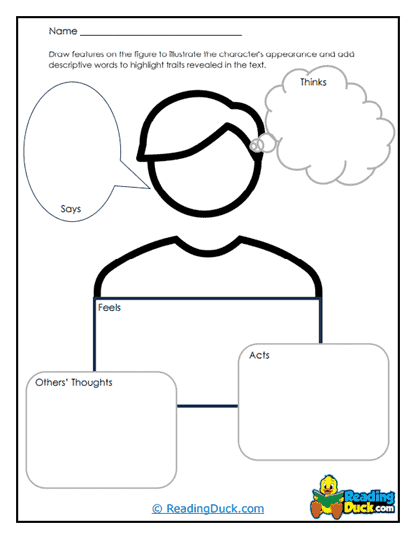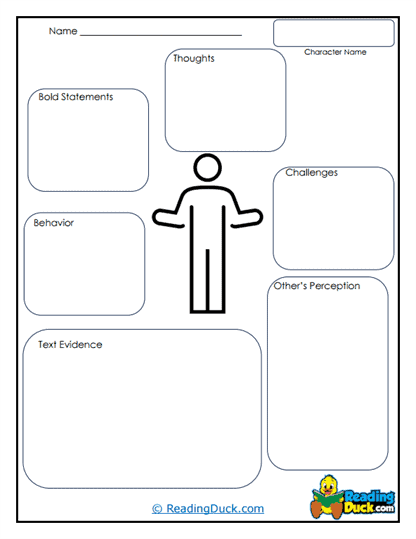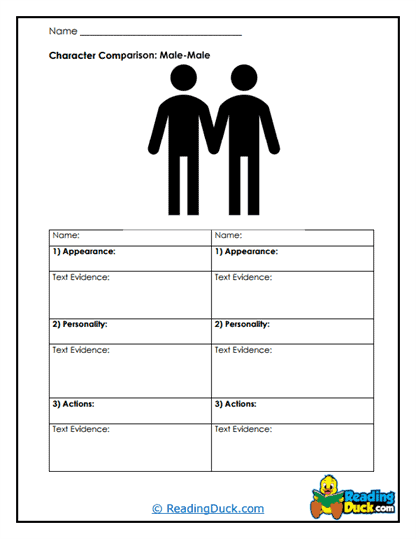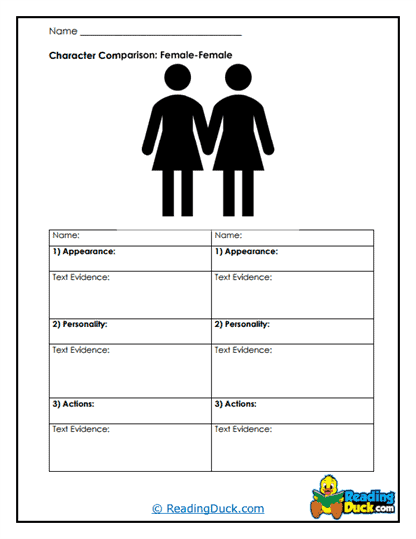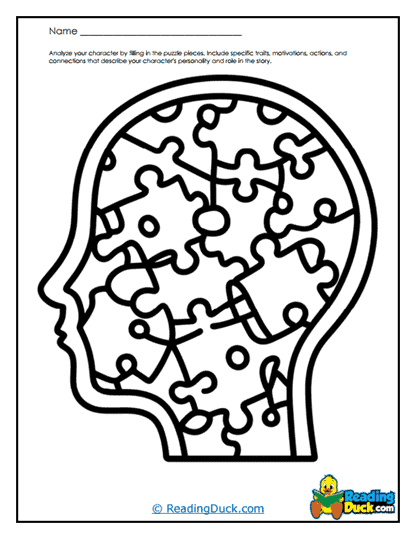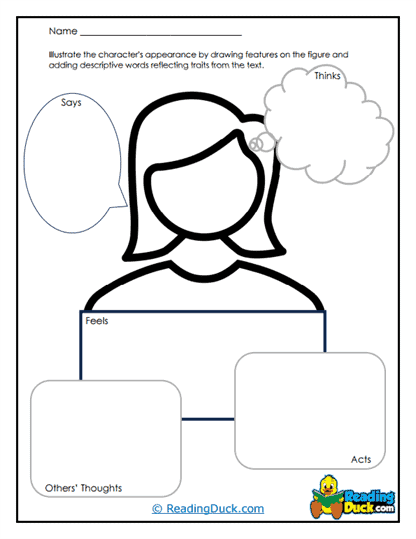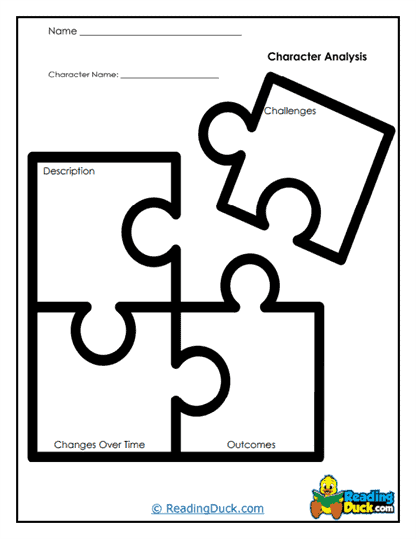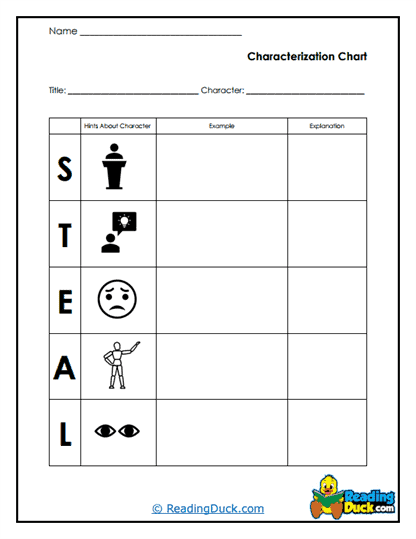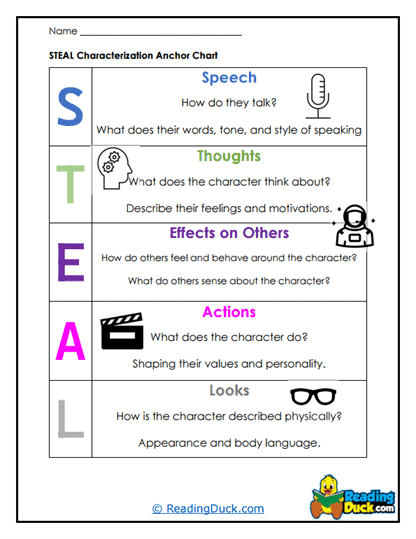Character Analysis Organizers Worksheets
About Our Character Analysis Graphic Organizers
Character analysis graphic organizers are visual tools designed to help readers and students systematically examine and understand a character in a story. These organizers break down complex information about a character into simpler, organized sections, making it easier to explore traits, relationships, motivations, and development. By using a graphic organizer, one can capture both surface-level and deeper details about a character, helping to enhance comprehension and critical thinking skills.
Our character analysis graphic organizers consist of specific sections or boxes, each prompting the user to consider a distinct aspect of the character. Common components include spaces for the character's name, role in the story, physical traits, personality characteristics, goals, and conflicts. Some organizers are shaped as webs or charts, while others use diagrams like flowcharts to show how a character evolves throughout the narrative. The structured layout ensures that all relevant aspects of a character are examined, from their outward appearance to their internal motivations.
The Benefits
One of the most significant benefits of character analysis graphic organizers is their ability to make the process of analyzing a character more accessible and engaging for a wide range of learners. These tools offer a structured, visual framework that helps users break down complex information about a character into manageable parts, making it easier to identify key traits, motivations, and roles. This structured approach is especially valuable for individuals who may feel overwhelmed by the prospect of analyzing a character in depth or for those who struggle to organize their thoughts in a clear and coherent manner. By offering prompts or designated sections for specific details, graphic organizers ensure that no important aspect of a character is overlooked.
Graphic organizers are particularly beneficial for visual learners or students who are new to literary analysis. For visual learners, the diagrammatic structure allows them to see the relationships between various elements of the character, such as how their traits influence their decisions or how their interactions with other characters shape the story. This visual representation enhances comprehension by turning abstract ideas into tangible, connected elements. For beginners, the clear prompts in graphic organizers serve as helpful guides, allowing them to focus on specific elements like personality traits or key moments in the plot without feeling overwhelmed. As a result, these tools build confidence and help learners gradually develop more advanced analytical skills.
They promote deeper critical thinking by encouraging users to make connections between different aspects of the character and the broader story. For instance, they might prompt users to consider how a character's motivations align with their actions, how their relationships influence the plot, or how their development reflects the story's themes. By visually mapping out these connections, users gain a more holistic understanding of the character and their significance within the narrative. Additionally, these tools are highly versatile and can be used to compare multiple characters, track character growth over time, or explore thematic elements through character interactions. This versatility makes them indispensable for fostering thoughtful engagement with literature.
Applications in Education and Literature
Character analysis graphic organizers are invaluable tools in educational settings, where they play a crucial role in enhancing literacy and analytical skills. Teachers frequently incorporate these tools into their lesson plans to help students navigate the often complex process of analyzing characters. By providing a structured framework, these organizers allow students to focus on specific elements, such as a character's traits, motivations, and relationships, without becoming overwhelmed. This not only helps them understand the material but also improves their critical reading skills as they learn to identify and interpret textual evidence to support their analysis. Furthermore, the process of completing a graphic organizer helps students practice organizing their thoughts, an essential skill for writing clear and coherent essays or reflections.
Beyond the classroom, character analysis graphic organizers are equally useful for individual readers who wish to deepen their engagement with a book. For avid readers or those studying literature independently, these tools can serve as a guide for tracking characters' development and uncovering hidden connections within the story. Graphic organizers encourage readers to move beyond surface-level understanding and delve into the deeper motivations and arcs of the characters. This reflective practice not only enhances appreciation of the text but also enables readers to develop their analytical thinking skills, which can be applied across a variety of contexts, from literary discussions to creative projects.
Writers developing complex characters for their own stories can also benefit greatly from using character analysis graphic organizers. By mapping out traits, backstories, and relationships, writers can ensure their characters are well-rounded and consistent. The visual nature of graphic organizers allows writers to see how different elements of a character-such as their motivations and conflicts-interact and drive the narrative. This organized approach not only aids in character creation but also helps writers identify gaps or inconsistencies in their character arcs. In this way, graphic organizers support both readers and creators in engaging deeply with literature, fostering a richer and more nuanced understanding of storytelling.
Performing a Character Analysis on a Story
Character analysis is a detailed examination of the traits, roles, relationships, and development of a character within a story. It helps deepen your understanding of the narrative and its themes by focusing on how the character contributes to the story's progression. Here's a step-by-step guide on how to effectively perform character analysis:
1. Understand the Purpose of Character Analysis
Before diving in, recognize why character analysis is important:
- It sheds light on the character's role in the story and their relationships with others.
- It helps interpret the story's themes and conflicts.
- It offers insights into the character's growth or decline, reflecting the story's broader messages.
2. Identify the Character's Role
Determine the character's function in the narrative:
Protagonist - The main character whose goals and conflicts drive the story.
Antagonist - The character opposing the protagonist.
Supporting Characters - Characters who aid or challenge the protagonist in various ways.
Dynamic/Static Characters - Assess whether the character evolves throughout the story (dynamic) or remains largely unchanged (static).
Round/Flat Characters - Round characters are complex with multiple dimensions, while flat characters are simpler, often defined by a single trait or role.
Understanding these roles helps frame your analysis in the context of the overall plot.
3. Gather Key Information About the Character
Collect data from the story, such as:
Physical Description - Note their appearance, attire, or physical traits. While this might not always be central, it can symbolize aspects of their personality or role.
Background - Consider their history, family, culture, or social standing. These factors often shape their motivations and actions.
Personality Traits - Identify core traits like bravery, selfishness, kindness, or ambition. Look for examples in the text that reveal these traits.
Behavior - Observe how the character acts in different situations. Are they consistent, or do their actions reflect growth or internal conflict?
4. Analyze the Character's Motivations and Goals
Ask yourself:
- What does the character want? (Goals)
- Why do they want it? (Motivations)
What challenges or obstacles do they face?
For example, a protagonist might strive for justice due to a personal loss. Understanding this can clarify the emotional stakes of the story.
